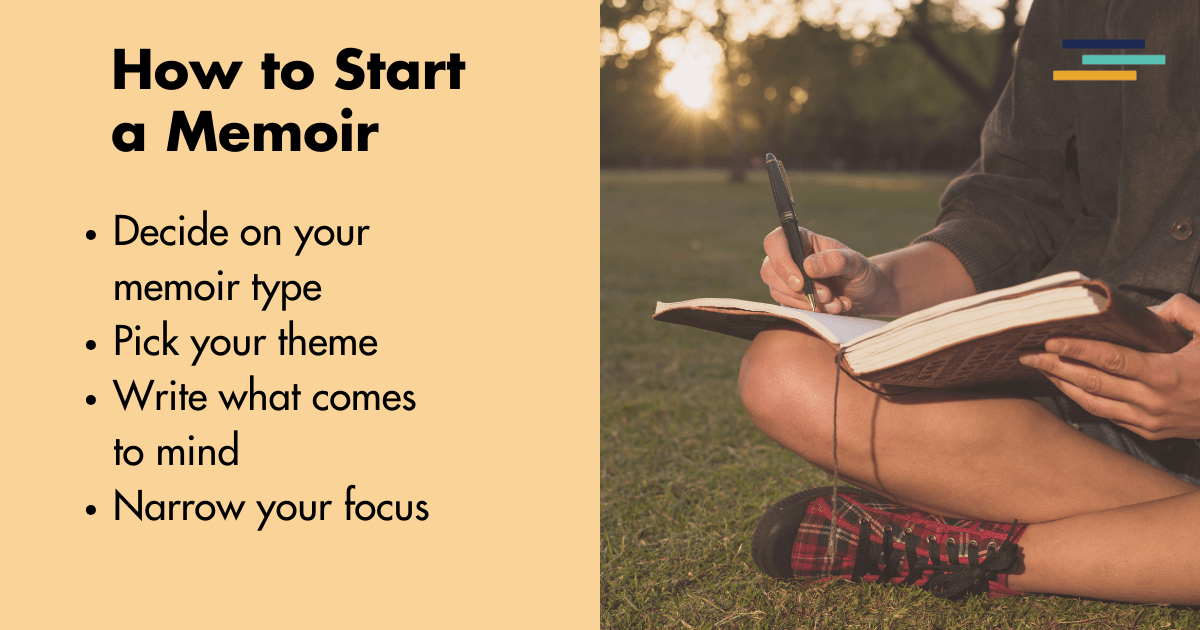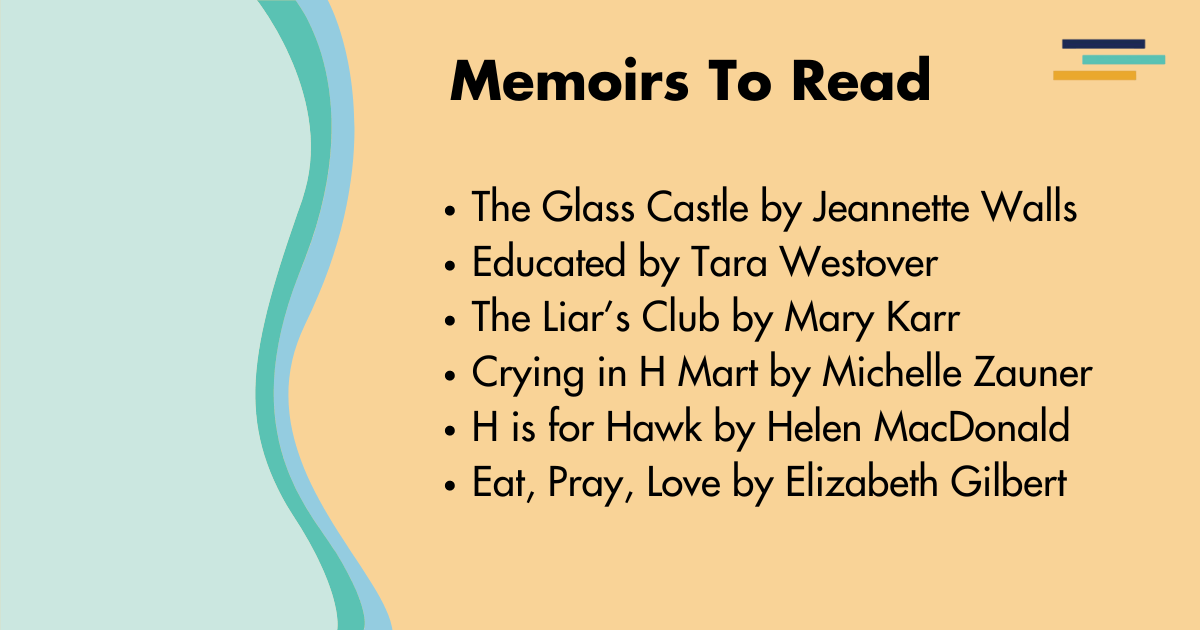
What happens when a writer wants to tell a true story about themselves? They become the protagonist and fill the chapters with scenes from their own lives. They share their personal character arc and the life lessons it imparts. That is a memoir.
What is a Personal Memoir?
The term memoir comes from the French word “mémoire,” which means memory or remembrance, reflecting the personal and reflective nature of the genre.
Memoirs can cover a wide range of topics, from childhood memories to professional accomplishments, and they often include emotional and introspective insights from significant moments, relationships, and events.
Memoir vs. Autobiography
A memoir focuses on a small slice, an event or series of related events, sometimes bound by theme, that have occurred in the writer’s life. They deliver a message.
An autobiography is the whole pie. It’s a linear, usually chronological accounting of a person’s entire life, typically written by someone with fame or prominence. For example, someone who has a high profile within their realm or beyond like a movie star, a politician, an athlete, or even a criminal.
While we all like to think we’ve led interesting lives, it’s unlikely that interest would prevail beyond our circle of family and friends. But everyday people have tales that can and should be told.
What to Include in a Memoir
When deciding what to write about, consider the 5 W’s: Who/What/Why/Where/When.

Who Am I Writing About?
The obvious answer is you. Who makes up your cast of characters? Friends, enemies, lovers, relatives, co-workers, your favorite teacher from sixth grade, the cop who arrested you, or the doctor who treated your cancer?
What Statement Am I Making?
Being able to reduce your book’s point to a statement, belief, or argument gives you focus and helps you evaluate it for its potential resonance. If you’re looking for revenge by sharing someone’s dirty laundry, it’s best to rethink your strategy.
A story about bringing someone else down rarely wins over the hearts of your readers. But if you want to illuminate the biggest life lesson you gleaned from your experiences to help others, by all means, write about it.
Why Am I Writing?
From an external standpoint, your “why” may involve recognition, validation, and income. These are all valid reasons.
The internal “why” may be harder to pinpoint. It could range from wanting to share what you’ve learned, to spare people from suffering like you did, to telling a story that touches people and helps them understand their own lives better.
Providing knowledge, comfort, encouragement, and inspiration to others appeals to our human need of finding meaning in the things that happen to us.
External Reasons:
- Gain notoriety
- Sell books
- Document family history
- Capture memories
- Establish my writing presence
Internal Reasons:
- Tell a personal story
- Discover the meaning of life
- Share knowledge
- Provide inspiration
- Validate myself as a writer
- Get healing through telling my story
Where Did My Story Take Place?
Even if you grew up in Chicago, you can’t take for granted that everyone knows what it’s like to experience life in the Windy City.
A small town in Texas or a quaint village in the English countryside also require enough description for your reader to feel like they’re experiencing it with you, the beauty, the horror, and the quirks.
When Did This Happen?
Anchoring your story in a time frame is important for your reader. Whether you’re a child of the 70s or Generation Z, when your story takes place is important and you need to place your readers in that time. Were you a child, a college student, or about to retire?
Writing a memoir does not involve inventing a world or characters out of thin air. It should be based on truth. However, truth is the eye of the beholder.
Picture a crime scene. Police interview the witnesses. Each gives a different account. Why? They might be standing in different locations so what they could see varied from the others. Their perspectives may differ because one witness thinks the victim resembles the neighborhood bully from their childhood. Another thinks every stranger is a criminal. Their life experiences shape the way they view everyday occurrences.
As we recall the events of our life, many things can color our memories like trauma, illness, prejudices, and even the simple passage of time. What did our memory choose to keep and why? This doesn’t mean we are being untruthful, rather, it is simply our version of the truth that we’re telling. Don’t feel constrained by your perspective. Embrace it.

How to Start a Memoir
Write what comes to mind. You can decide later what you’ll keep and what you’ll cut. Try to keep it related to the specific event, situation, or experience. Many memoir writing coaches suggest simply tapping into memories and writing them down.
Some people like to write a long, detailed account of events while others jot down a few lines. Some like to produce snippets in chronological order while others write whatever comes to mind. What’s most important is to have enough content to choose from when forming your story. This doesn’t mean writing your life story. (Save that for when you’re making the talk show circuit celebrating your worldwide success.)
Once you’re ready to write your first draft, begin by writing a simple summation of your story, just like you would for a novel. Develop a one-sentence premise of your memoir. Remember, make it about one specific situation and what you learned from it.
If you’re having trouble, imagine writing a skeleton blurb for a novel. Who is the protagonist? You! What shook your world up? How did you respond? In what ways did your life change after going through this situation?
Different Types of Memoirs
Now that you’ve gotten started, decide what kind of story you’re telling. Here are the more common types of memoirs:
- Traditional Memoirs: These are retrospective, recounting significant life events and providing a comprehensive exploration of the author’s experiences and emotions.
- Childhood Memoirs: These transport readers back to the author’s formative years, capturing innocence, challenges, and the profound impact of early experiences, tapping into the universal human longing to understand one’s roots.
- Coming-of-Age Memoirs: These navigate the tumultuous waters of adolescence, exploring themes of self-discovery, forming one’s identity, and the trials of growing up.
- Transformative Journey Memoirs: These delve into pivotal moments or journeys that changed the author’s life, resulting in personal transformation through travel, self-discovery, or overcoming adversity.
- Historical Memoirs: These intertwine personal experiences with historical events. Using a backdrop of wars, revolutions, cultural shifts, or other significant periods, authors share their perspectives using a unique lens through which readers can understand historical events.
- Confessional Memoirs: These are deeply personal and often raw stories revealing intimate details, vulnerabilities, and struggles, inviting readers into their emotional landscapes.
- Educational Memoirs: These combine personal stories with lessons learned. Authors share wisdom and insights gained from their experiences, aiming to offer inspiration or guidance to others.
- Retrospective Memoirs: These look back on a specific time or event in the author’s life, offering reflections, insights, and a sense of newfound understanding and closure.
- Thematic Memoirs: These memoirs weave together different stories and events from the author’s life to illustrate a central theme, such as love, loss, or betrayal.
- Chronological Memoirs: These tell the story from start to finish, providing a linear narrative of the author’s journey for that portion of their life.
Within each of these types of memoirs, there is an external story and an internal story. The external story focuses on the events themselves, such as surviving war, abuse, or tragedy. The internal story reflects the growth of the character in response to those events.
What to Write a Memoir About
Consider these things when writing your memoir:
- Who is your book for: Having a target audience will help you focus on the message you want to share.
- Write with honesty and authenticity: Being vulnerable can make your story more relatable and compelling. Only you know what it was like to take your journey. Tell it with the emotion of the triumphs and challenges you experienced.
- Show, Don’t Tell: Though it might tempt you to merely lay out the events in a journalistic way, strive to show what happened with dialogue, vivid descriptions, and sensory details. Bring to life the people, places, and events as you experienced them.
- Character Development: Even if you are the only character in your story, you need to show who you are to your readers. Develop yourself and others in your memoir with depth, showing motivations, strengths, weaknesses, and growth.
- Prose: Pay attention to the craft of writing. Most memoirs are written from a first-person point of view in order to establish a connection with readers. It is possible to write from a third-person point of view, but it may create a more objective or detached perspective. It may be suitable if your story involves more than just you as the protagonist, such as siblings whose experiences are intertwined. You’ll also decide which tense to use. Be consistent. Watch your pacing and narrative flow.
What Is Good Memoir Structure?
While a memoir involves writing about personal events and recollections, the story still requires the same solid story structure as a novel.
It’s true that in a novel there can be three points of view—the author, the perspective from which the story is told, and the main character or protagonist who lives the story.
In memoirs, these three are one and the same. This presents a critical lesson: a memoirist must determine what they know and how they should reveal it to the reader.
Another important point to consider is that of truth. Remember that one person’s account may vary from another and yet remain truthful due to varying perceptions. You may not remember the exact words exchanged in a conversation, but the gist of the message should remain.
Memoir Writing Tips
Before getting to the structure, consider these tips:
- Narrow your focus: Remember, you’re not writing an autobiography. You’re focusing on one moment or series of moments around a theme.
- Write about more than the story: Yes, the focus is on an event or related events, but consider the other players—the characters, the time, and the setting. Share interesting facts about them in your writing to bring vivid details to life.
- Use fictional elements: While your memoir is a true story, you can and may need to embellish it, depending on how vivid your memory is. When focusing on other characters, locations, and dialogue, create intriguing details about them to evoke emotions in your readers. This will not compromise the integrity of your story; it will keep your reader mesmerized.
- Be careful with pacing: Determine the rhythm of your story. Some events may need more detailed exploration, while others can be summarized to maintain the flow.
- Have a narrative arc: Your memoir should have a clear beginning, middle, and end.
Memoir Structure
It makes sense to approach your memoir’s structure like that of a novel. It needs the following components:
- Opening Image: Start with a compelling hook or scene that establishes the setting, time, and key characters.
- Setup/Exposition: These scenes show what your ordinary world is like, setting the tone before changes come. It helps to establish what’s at stake for you.
- Inciting Incident: Introduce the main conflict that sets your story into motion. What happens that shakes up your world and causes you to react?
- Plot Point 1: At this stage, you know what your goal is, but you’re not thrilled about chasing it. Since you’re in reactionary mode, your actions may not be related to achieving the goal.
- Middle: The middle marks the point where you become proactive to the goal. This means you’ve learned the rules, and you can now make plans to go after the goal. No longer just accepting your fate, you’re finding the strength to deal with the obstacles in your path. How do you grapple with the challenges, make decisions, and demonstrate personal growth?
- Plot Point 2: It is the low point in your story where it seems all is lost. Have your efforts to reach your goal resulted in failure or brought more hardship? Were you lacking knowledge or had incorrect information that led you to make unwise choices?
- Climax: This is where you achieve (or fail to achieve) your story’s goal. The tension, conflict, and emotional upheaval reach their peak in this scene and offer your reader the payoff to the story’s promise. This is your moment of triumph, crisis, self-realization, or transformation.
- Resolution: Wrap up by reflecting on lessons learned, personal growth achieved, and the impact of the events on your life. You may offer insights or wisdom gained from your experiences.
Memoir Examples
Here are some highly regarded books which offer guidance on writing memoirs:
The Art of Memoir by Mary Karr
Mary Karr, a celebrated memoirist, shares her wisdom and experience in this book, offering theoretical insights and practical advice on crafting compelling memoirs while reflecting on her writing journey.
Writing the Memoir: From Truth to Art by Judith Barrington
This book provides a comprehensive guide to writing memoirs, covering topics such as memory, structure, voice, and revision.
Fearless Confessions: A Writer’s Guide to Memoir by Sue William Silverman
Sue William Silverman draws upon her own personal and professional experience to provide a practical guide for transforming life into words that matter.
The Memoir Project: A Thoroughly Non-Standardized Text for Writing & Life by Marion Roach Smith
This concise and engaging book emphasizes the importance of storytelling and personal voice in memoir writing.
Your Life As Story by Tristine Rainer
Tristine Rainer fills her book with examples from renowned writers and demonstrates techniques for crafting character portraits, remembering forgotten memories, unifying a story with thematic conflict, and employing fictional devices such as dialogue and humor.
Bird by Bird: Some Instructions on Writing and Life by Anne Lamott
A classic offering advice on writing and life, encouraging writers to take it one step at a time and to find humor in the process. It’s a valuable resource for writers of all genres.
Naked, Drunk, and Writing: Shed Your Inhibitions and Craft a Compelling Memoir or Personal Essay by Adair Lara
Lara guides writers through the process of writing their stories with authenticity and courage, helping them to craft a narrative that resonates with readers.

Great Memoirs to Read
If you want to be inspired, here are some critically acclaimed memoirs to read:
The Glass Castle by Jeannette Walls
Walls’ memoir chronicles her unconventional upbringing by deeply dysfunctional parents, exploring themes of resilience, family, and forgiveness.
Educated by Tara Westover
This memoir tells the story of Westover’s self-transformation from growing up in a strict, isolated household in rural Idaho to eventually pursuing higher education at Cambridge and Harvard.
The Liar’s Club by Mary Karr
Karr’s memoir offers a candid and often humorous account of her turbulent childhood in East Texas, marked by her dysfunctional family and her own struggles with addiction.
Crying in H Mart by Michelle Zauner
This memoir is a touching tale of growing up Korean-American, dealing with family bonds, cultural identity, and grief.
H is for Hawk by Helen MacDonald
Part memoir, part nature writing, MacDonald’s book explores her experience of grief and healing following her father’s death, intertwined with her journey of training a goshawk.
A Long Way Gone: Memoirs of a Boy Soldier
A testament to the resilience of the human spirit, Beah’s story of his transformation from an innocent child to a child soldier during Sierra Leone’s civil war recounts his harrowing experiences.
Drinking: A Love Story by Caroline Knapp
A powerful narrative of Knapp’s love affair with alcohol, her struggle with addiction, and her courageous path to recovery.
Eat, Pray, Love by Elizabeth Gilbert
Gilbert explores themes of spirituality, love, and the quest for inner peace on a year-long journey of self-discovery following a divorce.
Conclusion on Writing a Memoir
Writers are passionate about telling the stories they’ve created in their minds. Memoir writers have lived their stories and want to share their messages of hope and inspiration or perhaps experience a catharsis of their own. In any case, memoir is a valuable genre worth considering for any writer.


